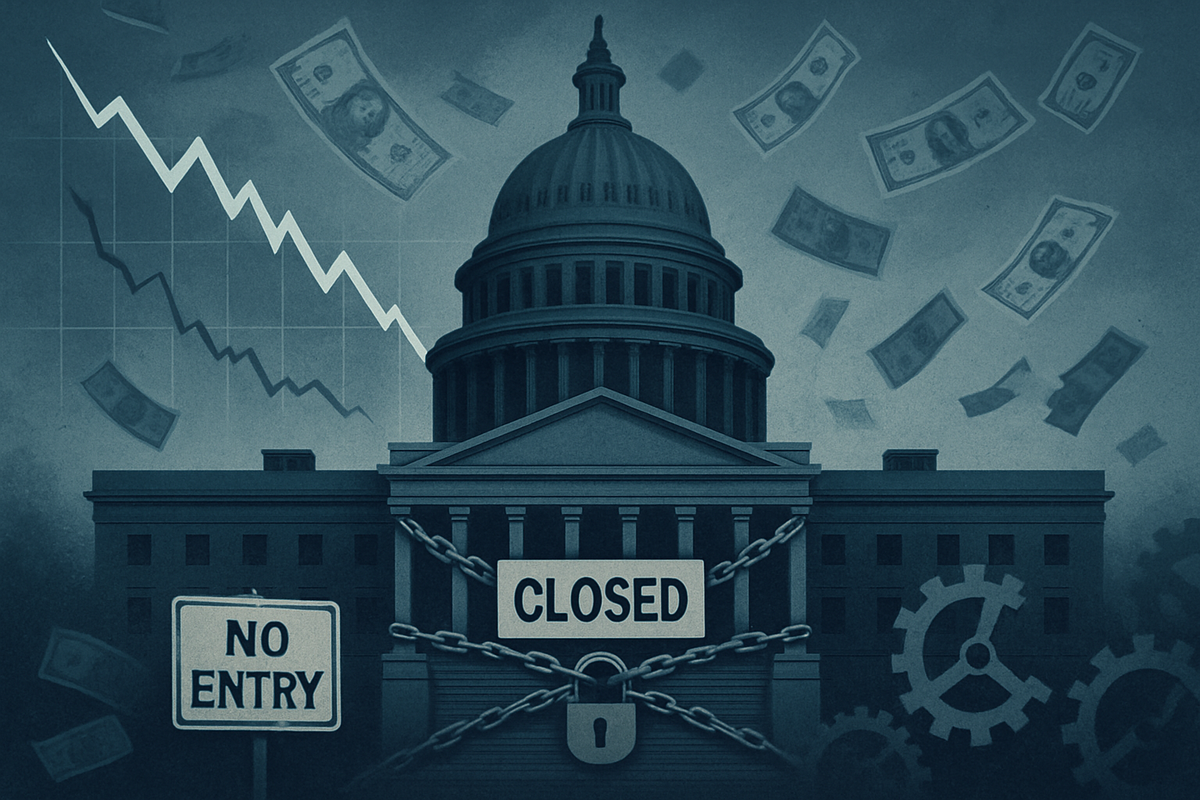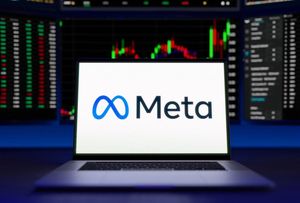Financial News
US Government Stumbles into Prolonged Shutdown: Economic Fallout and Market Uncertainty Mount

As of October 20, 2025, the United States federal government finds itself mired in a deepening shutdown, now entering its third week. This fiscal impasse, which began on October 1st, stems from a failure by Congress to enact crucial funding legislation for the 2026 fiscal year. The prolonged closure is rapidly generating significant economic headwinds, disrupting essential government services, and casting a long shadow of uncertainty over financial markets already grappling with various global challenges. With each passing day, the immediate implications—ranging from furloughed federal workers to stalled agency operations—are escalating, threatening to inflict substantial and potentially lasting damage on the nation's economic stability.
The current shutdown, marking 20 days of federal paralysis, is not merely a political standoff but a tangible economic event with real-world consequences. Businesses reliant on federal contracts face payment delays, vital regulatory functions are suspended, and hundreds of thousands of federal employees are either working without pay or furloughed, leading to a direct hit on consumer spending and local economies. The financial markets are reacting with heightened volatility, as investors weigh the potential for a protracted shutdown to derail economic growth and corporate earnings, making the resolution of this fiscal crisis a paramount concern for policymakers and the public alike.
The Fiscal Impasse: A Deep Dive into the Current Crisis
The genesis of the current government shutdown can be traced back to the failure of Congress to pass the necessary appropriations bills or a continuing resolution to fund federal operations for the 2026 fiscal year, which commenced on October 1, 2025. This legislative stalemate has forced numerous federal agencies to cease all "non-essential" operations, leading to widespread furloughs and a significant curtailment of government services. The specific details surrounding the impasse involve intense disagreements between the Executive Branch, led by the President, and both chambers of Congress over spending priorities, budget allocations, and potentially contentious policy riders attached to funding bills.
The timeline leading to this moment was characterized by weeks of increasingly fraught negotiations that ultimately broke down as the September 30th deadline approached. Despite last-minute efforts, lawmakers failed to bridge their differences, triggering the shutdown at midnight on October 1st. For the past 20 days, the nation has witnessed the gradual escalation of its effects, from initial furloughs to growing backlogs in critical services. Key players involved include the President, who has been vocal in demanding specific budget concessions; the leadership of the House of Representatives and the Senate, who have struggled to unite their respective caucuses; and, most directly, the hundreds of thousands of federal employees and their families who are bearing the immediate financial brunt. Stakeholders extend to every American citizen who relies on federal services, from national park visitors to businesses awaiting permits or regulatory approvals.
Initial market reactions have been predictably negative. The prospect of reduced government spending, delayed economic data releases, and a dent in consumer confidence has led to increased volatility across major indices. While specific industry reactions vary, sectors heavily reliant on government contracts or regulatory oversight have shown particular sensitivity. For instance, defense contractors (e.g., Lockheed Martin - NYSE: LMT, Boeing - NYSE: BA) and IT service providers to the government (e.g., Leidos - NYSE: LDOS, Booz Allen Hamilton - NYSE: BAH) often face payment delays or project suspensions, impacting their revenue streams and investor outlooks. The general sentiment is one of caution, as analysts attempt to quantify the economic damage and predict the duration of the fiscal standoff.
Winners and Losers: Corporate Fortunes Amidst Federal Furloughs
A government shutdown inevitably creates a bifurcated landscape for public companies, with some facing significant headwinds while others might experience minimal impact or even indirect benefits. The most immediate and pronounced losers are often government contractors. Companies like Lockheed Martin (NYSE: LMT), Boeing (NYSE: BA), General Dynamics (NYSE: GD), Northrop Grumman (NYSE: NOC), and IT service providers such as Leidos (NYSE: LDOS) and Booz Allen Hamilton (NYSE: BAH) rely heavily on federal contracts for a substantial portion of their revenue. During a shutdown, new contracts are typically put on hold, and payments for existing work can be delayed, leading to cash flow issues, project delays, and potential workforce reductions among their own employees. This directly impacts their earnings outlook and can cause their stock prices to underperform.
Beyond direct contractors, sectors reliant on federal permits, inspections, or data can also suffer. For example, environmental consulting firms or construction companies awaiting federal permits for infrastructure projects might see delays. The tourism industry, particularly companies operating near national parks (e.g., Xanterra Travel Collection, though privately held, its parent Berkshire Hathaway - NYSE: BRK.A, BRK.B could see indirect impacts on its hospitality portfolio), can experience a drop in business due to park closures. Furthermore, any company whose business model is significantly tied to consumer spending could feel the ripple effect of furloughed federal workers reducing their expenditures.
Conversely, some companies might be less affected or even see indirect benefits. Companies providing essential services that are funded through alternative mechanisms or deemed critical for national security might continue operations with fewer disruptions. Firms with minimal or no exposure to federal contracts or regulatory processes are generally insulated. In some instances, the increased uncertainty could drive demand for "safe-haven" assets, potentially benefiting companies in the financial sector that offer such products, or even certain large, diversified conglomerates with strong balance sheets that are seen as more resilient during economic turbulence. Companies operating primarily in state or local government markets, or purely in the private sector, are also likely to fare better.
The impact also extends to financial services. Banks and credit unions operating in areas with high concentrations of federal employees might see an uptick in demand for short-term loans or credit lines to cover living expenses during the shutdown. While this can present a short-term opportunity, it also carries increased credit risk. Ultimately, the broader economic slowdown caused by the shutdown will likely dampen overall market sentiment, making it challenging for most companies to thrive, emphasizing that the "winners" are more accurately described as those least harmed.
Broader Implications and Historical Context
The ongoing government shutdown extends its reach far beyond immediate federal operations, weaving itself into the broader fabric of the US economy and financial markets. This event exacerbates existing uncertainties, particularly regarding inflation, interest rate policy, and global supply chain stability. For instance, the delay in releasing key economic data, such as inflation reports or employment figures, can hinder the Federal Reserve's ability to make informed monetary policy decisions, potentially leading to increased market speculation and volatility. Consumer confidence, a crucial driver of economic growth, is likely to erode further as the spectacle of political gridlock and financial insecurity dominates headlines, prompting households to reduce discretionary spending.
The ripple effects are far-reaching, impacting competitors and partners across various industries. Businesses that rely on federal research grants or partnerships, particularly in sectors like biotechnology and advanced manufacturing, could see their innovation pipelines disrupted. Small businesses, which often have tighter cash flows, are particularly vulnerable to delays in government payments or the cessation of federal loan guarantees. Internationally, a prolonged shutdown can project an image of political instability, potentially affecting foreign investment in US assets and weakening the dollar against other major currencies.
Regulatory and policy implications are also significant. New regulations or policy initiatives, which could impact industries from energy to healthcare, are effectively frozen. Critical environmental inspections, food safety checks, and drug approvals may be delayed, posing risks to public health and safety and creating backlogs that will take months to clear even after the government reopens. This regulatory paralysis can create uncertainty for companies planning new projects or product launches, potentially stifling economic activity.
Historically, government shutdowns have consistently demonstrated a dampening effect on economic growth. The Congressional Budget Office (CBO) estimated that the 35-day shutdown from December 2018 to January 2019, the longest in US history prior to the current one, cost the American economy at least $11 billion, with a permanent loss of about $3 billion that was not recouped. It also reduced GDP growth by 0.1% in Q4 2018 and 0.2% in Q1 2019. Given the current shutdown is rapidly approaching or has already surpassed this duration, the economic costs are expected to be substantial, with potential for even greater long-term damage due to the prevailing economic conditions in late 2025.
Navigating the Uncertainty: What Comes Next?
The path forward for the US economy and financial markets amidst this prolonged government shutdown remains shrouded in uncertainty, presenting both short-term challenges and long-term strategic considerations. In the immediate future, the most critical outcome is the resolution of the fiscal impasse. Short-term possibilities include a temporary continuing resolution to reopen the government while negotiations continue, or a more comprehensive budget agreement. However, the longer the shutdown persists, the greater the likelihood of accumulating economic damage, making a swift and decisive resolution paramount to prevent further erosion of consumer and business confidence.
For businesses, particularly those with federal ties, strategic pivots are becoming increasingly necessary. Government contractors may need to diversify their client base, explore commercial markets, or implement contingency plans for future fiscal uncertainties, including maintaining larger cash reserves to weather payment delays. Federal agencies, meanwhile, will face significant challenges in restoring full operations, addressing backlogs, and rebuilding morale among their workforce once funding is restored. This could lead to a sustained period of inefficiency even after the shutdown officially ends.
Market opportunities, though scarce in a climate of uncertainty, might emerge for companies offering solutions that help mitigate the impact of government disruptions, such as financial services catering to furloughed employees or technologies that streamline government processes for future resilience. Conversely, the primary challenge remains the broad economic slowdown, which could lead to reduced corporate earnings across various sectors, particularly if consumer spending significantly declines. Investors will be closely watching for signs of political compromise, but also for economic data points that can still be gathered, such as private sector employment figures and retail sales, to gauge the depth of the shutdown's impact.
Potential scenarios range from a relatively quick resolution that allows for a modest economic rebound in early 2026, to a protracted standoff that pushes the US economy towards a significant downturn. A prolonged shutdown could also force the Federal Reserve to reconsider its monetary policy stance, potentially delaying anticipated rate adjustments or even prompting emergency measures if economic conditions deteriorate severely. The ultimate outcome will depend heavily on the political will to compromise and the ability of policymakers to prioritize economic stability over partisan divides.
Concluding Thoughts: Assessing the Lasting Impact
The ongoing US government shutdown is more than a fleeting political event; it represents a significant economic stress test with potentially lasting ramifications for the nation's financial health and market stability. The immediate takeaways are clear: a direct hit to GDP growth, widespread disruption of federal services, and a severe financial strain on hundreds of thousands of federal employees and countless businesses. The longer the shutdown endures, the deeper the economic scars will become, making a full recovery more challenging and protracted.
Moving forward, the market will likely remain highly sensitive to any developments emanating from Washington. Investors should anticipate continued volatility until a clear path to resolution emerges. The current situation underscores the inherent risks of political gridlock and its capacity to directly impact corporate earnings, consumer behavior, and overall economic momentum. Companies with robust balance sheets and diversified revenue streams will be better positioned to weather this storm, while those heavily reliant on federal activity or operating with thin margins may face considerable distress.
The lasting impact of this shutdown could manifest in several ways: a recalibration of business strategies to account for increased government uncertainty, a potential erosion of international confidence in US economic governance, and a renewed debate over the fundamental processes of federal budgeting. What investors should watch for in the coming months includes not only the legislative progress towards reopening the government but also key economic indicators post-shutdown, such as unemployment figures, consumer spending data, and corporate earnings reports, to fully assess the extent of the damage and the pace of any recovery. This event serves as a stark reminder that political decisions can have profound and immediate financial consequences, necessitating careful monitoring and strategic adaptation from all market participants.
This content is intended for informational purposes only and is not financial advice
More News
View More




Recent Quotes
View More
Quotes delayed at least 20 minutes.
By accessing this page, you agree to the Privacy Policy and Terms Of Service.



